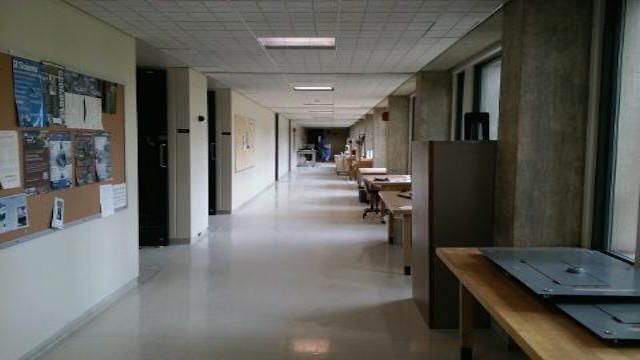The labs that were previously located there have not been upgraded since the building opened in 1967, Owen Evans, Director of Laboratories in Geo-Sciences, said. Photo by Julio Avila (Oct. 8, 2015)
By Julio Avila
Staff Writer
A second-floor wing of the Earth and Space Science building will get an estimated $1.5 million state-funded face-lift to house new laboratories and rooms for geology-related research.
The 6,200 square feet of renovated space will include a wet-chemistry lab and a spectroscopy lab with a dark room. It will also include a conference room and a “bullpen” where students and professors can collaborate on work.
The labs that were previously located there have not been upgraded since the building opened in 1967, Owen Evans, director of laboratories in geo-sciences, said.
“No matter how good the original construction was, things change,” Evans said. “Probably more importantly, your needs change and the purposes: the things you would want to do with space change.”
The laboratories that existed, such as four outdated darkrooms for film processing and an x-ray room, are no longer in use. These labs became obsolete as technology became digital, according to Evans.
“We are constantly working hard to extract the maximum value out of everything about this operation,” Evans said. “Make the best use of space, do the best science we can, spending the least amount of money so that we have more money to push the science farther.”
Evans said the renovations will begin in October and will have an estimated completion time of a year. The professors spearheading the project are Timothy Glotch, Joel Hurowitz and Deanne Rogers.
The wet-chemistry lab will belong to Joel Hurowitz, a professor specializing in chemical-related geology. Some of the functions, he said, his new lab will have are a lab-version of a “flight-like” instrument that will be sent to Mars in 2020 and equipment with the potential to analyze samples of sediment collected by students for composition analyzation.
“Everybody sort of purpose-builds a laboratory to suit their particular research needs,” Hurowitz said. “It’s important for any one investigator to have their own space that they can set up in a way that best serves their research purposes.”
Hurowitz currently shares lab-space with other professors with whom the labs originally belong to. He said it “hasn’t been much of a struggle” sharing labs and that it allows for collaboration with his colleagues.
His request for a new lab required an outline on the work he would do, space needed, technology needed and costs. This would be negotiated between the department chair, Dan Davis, the dean of the College of Arts and Sciences and with the Provost’s office. After negotiations, a total cost is determined on how much money will be spent on lab construction.
Once completed, the “Center for Planetary Exploration,” the name dubbed for the wing, Hurowitz said, will be a “new place to call home.”
“It’ll be a really nice sort of showcase for the university’s involvement in NASA’s missions.” Hurowitz said. “It’ll be a part of our building that people can come to and really see how actively engaged and involved Stony Brook is in NASA research.”


